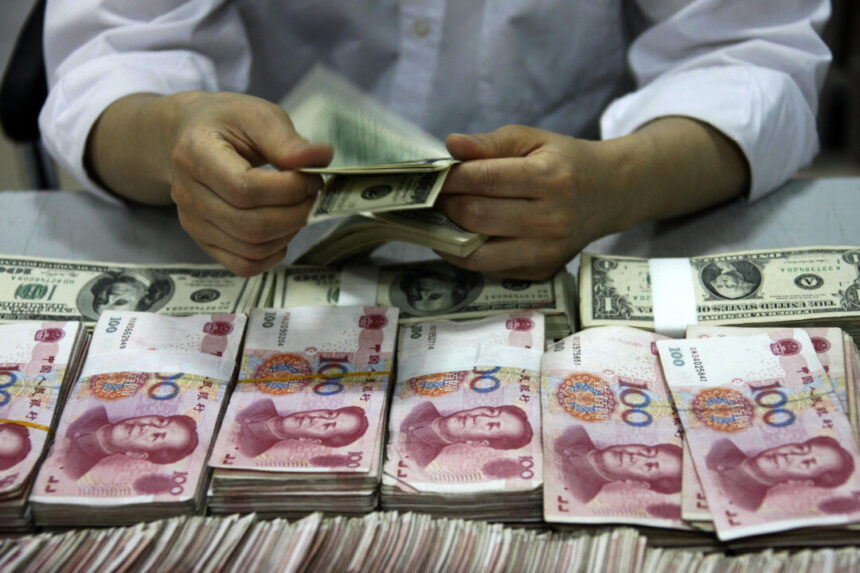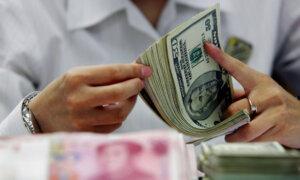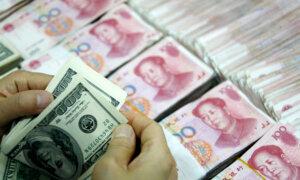Commentary
With the yuan weakening, Chinese citizens and businesses are looking for ways to avoid their own currency.
Since around 2014, the U.S. dollar (USD) has consistently strengthened against the Chinese yuan (RMB). Back in 2014, the exchange rate was approximately 6.1 yuan per dollar. Crossing the 7-yuan mark per dollar was seen as a psychological barrier that Beijing preferred to avoid. However, in the past year, the yuan has remained above 7.
The advantage of a weak currency is that exports become more affordable. As the dollar can now purchase more yuan, goods priced in yuan become attractive for Americans. However, the downside is that imports must be paid for in dollars, including essential commodities and energy. Consequently, a weaker yuan makes it more costly for Chinese factories to procure raw materials and operate their machinery.
Exporters and other business individuals are opting to keep their cash in currencies other than the yuan and only convert what they require. They have two main reasons for being pessimistic about the yuan. Firstly, the Chinese economy does not show immediate signs of recovery. While there have been slightly more positive indicators in the past month, such as a slight increase in factory activity, this may not indicate a sustainable trend. Moreover, it will require more than a slight uptick in manufacturing to generate employment opportunities for the millions of unemployed youth.
In March, exports were down 7.5 percent compared to the previous year. This is concerning for the economy, especially for those looking to divest from yuan, as exports are a primary means of acquiring dollars. Additionally, despite the low cost of borrowing, with interest rates at only 1.5 percent, Chinese businesses are finding it challenging to earn enough returns to cover the interest.
Another reason for the lack of optimism in the yuan’s recovery is the strength of the dollar, which is expected to persist in the near future. When U.S. interest rates are high, as they have been for almost a year, the dollar appreciates in value. This typically leads to capital outflow from China and other countries as investing in the U.S. becomes more lucrative. Chinese investors can earn 5 percent by depositing their dollars in the U.S., whereas they would only gain 1.5 percent interest if they converted them to yuan and deposited them domestically.
The movement of investments out of China and into the U.S. contributes to the depreciation of the yuan and other currencies while strengthening the dollar further. The dollar may lose value if interest rates decrease, but given the ongoing inflation in the U.S., the Federal Reserve is unlikely to cut rates. As a result, investors are shifting their funds from yuan to dollars or gold.
The People’s Bank of China (PBOC) has been increasing its gold purchases, and Chinese citizens are turning to buying jewelry as a way to store their wealth in gold rather than the depreciating yuan. Gold also serves as an alternative to the Chinese stock market, which has lost $6 trillion in value over the past three years. For the past 17 months, the PBOC has been adding to its gold reserves, leading to record-high gold prices. The surge in gold prices presents a mixed scenario for Chinese banks and investors who have to use depreciating yuan to purchase increasingly expensive gold.
Chinese citizens and exporters are not the only ones hesitant to hold the yuan; the rest of the world shares the sentiment. The global share of the Chinese yuan in currency reserves has dropped to a three-year low. After reaching a peak of 2.83 percent in 2020, the percentage of Chinese yuan held by central banks globally has steadily declined, reaching 2.29 percent by the end of 2023. The dollar continues to be the preferred reserve currency. Despite the PBOC’s consistent gold purchases over the past 17 months, the ratio of gold to dollars in its reserves has remained unchanged.
When the yuan was included in the International Monetary Fund (IMF) Special Drawing Rights (SDR) currency basket in 2016, Xi Jinping believed it marked a significant step towards the internationalization of the yuan and the displacement of the dollar as the world’s currency. However, eight years later, the yuan has not emerged as a major reserve currency, and its usage in trade settlements has only reached 4.6 percent.
The road ahead for the yuan to replace the dollar is long, with the first step being for Chinese exporters to embrace the yuan, a step they are currently reluctant to take.
Views expressed in this article are opinions of the author and do not necessarily reflect the views of The Epoch Times.
Please rewrite the following sentence:
“The company’s new product line is expected to revolutionize the industry.”
“The industry is anticipating a revolutionary impact from the company’s new product line.”
Source link







